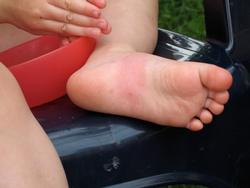Bee Safety
Honey bees are known to defend their colonies by stinging anyone or anything that may threaten their safety and their resources (honey and young bees). A foraging bee, a bee flying from flower to flower, is not a threat. A foraging bee is not looking to intentionally sting anyone because is does not have its resources to protect. However, if a foraging bee feels threatened by someone swatting at it or if someone accidently touches it or steps on it, it could sting.
Although one out of every hundred individuals may experience significant swelling when stung by a bee, they are not considered to be truly allergic. True allergic signs from a bee sting include difficulty breathing, hives, swelling of the face, throat, or mouth, anxiety, rapid pulse, and a drop in blood pressure, which all have the potential to lead to death. Individuals with severe allergies are advised to carry injectable epinephrine (EpiPen), to use immediately after a bee sting. About 2 million Americans are considered to be severely allergic to bee stings. Nonetheless, non-allergic people and animals can die from too many bee stings because of the amount of venom entering the body. This is around 200 to 500 stings per child and over 1,100 per adult.

Photo Source: Lee Bryant on Flickr.com (CC License)
What should I do if I’m stung by a bee?
- When a bee stings, its stinger and venom sack is left in the victim and continues to pump venom into the body until it is removed. Therefore, remove stingers as soon as possible.
- Be careful not to squeeze the venom sack when removing it; that will just release more venom into the victim. Instead use a dull knife, edge of a credit card or fingernail for removal.
- Wash stings with soap and water to prevent infection.
- Apply ice to relieve the pain and swelling.
- Use an over-the-counter antihistamine to reduce inflammation.
- If an allergic reaction occurs, call 911.
If a swarm or colony is disturbed:
- Get away from bees as quickly as possible.
- Seek shelter in a vehicle, shed, house, or other structure.
- Do not jump into water or hide in bushes.
- Do not swat at the bees; rapid movements will agitate them further.
- Call 911 if someone is being attacked.
What can I do to protect my home and family from bee stings
- Don’t bother, swat at, or tease foraging bees in the garden or landscape.
- Inspect property regularly for potential bee nesting sites and bee activity, such as openings in vents, rain spouts, water meter/utility boxes, tree cavities, garages, sheds, grills, etc.
- Listen for buzzing and look for bees entering or leaving an area. Bees flying quickly in a straight line in and out of an area may indicate the presence of a colony.
- Consider the Sensitive Site Opt-In program offered by the County of San Diego.
What should I do if I locate a swarm or colony of bees on my property?
- Stay away from any honey bee colony you find nesting.
- Do not try to treat or remove the colony or swarm yourself.
- Swarms (a cluster of bees with no wax, honey, or young bees and usually found hanging in trees or on eaves) will typically move by themselves within a few days.
- Contact a trained and registered beekeeper or licensed pesticide applicator to have the colony removed or eradicated.
Additional Resources:
USDA – Bee Stings/Safety
UC IPM – Bee and Wasps Stings
County of San Diego - How to Protect Yourself from Africanized Honey Bee
